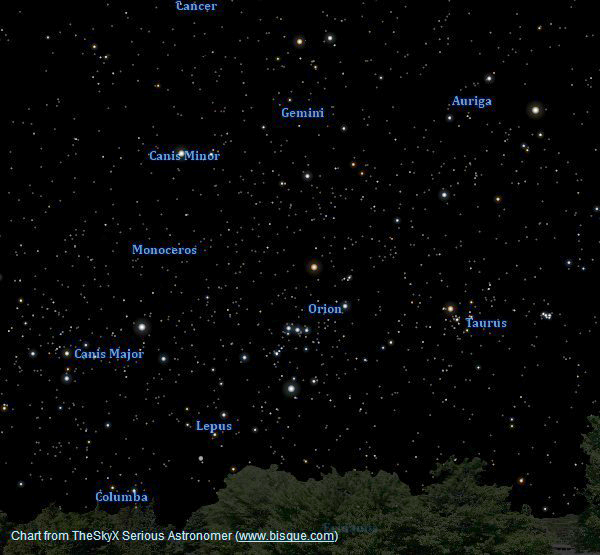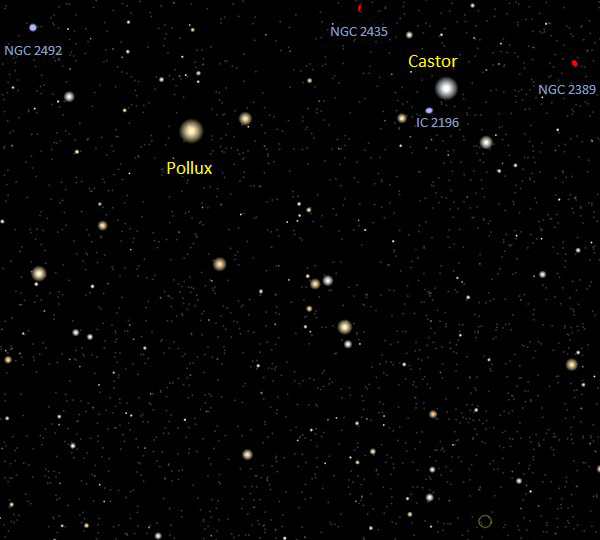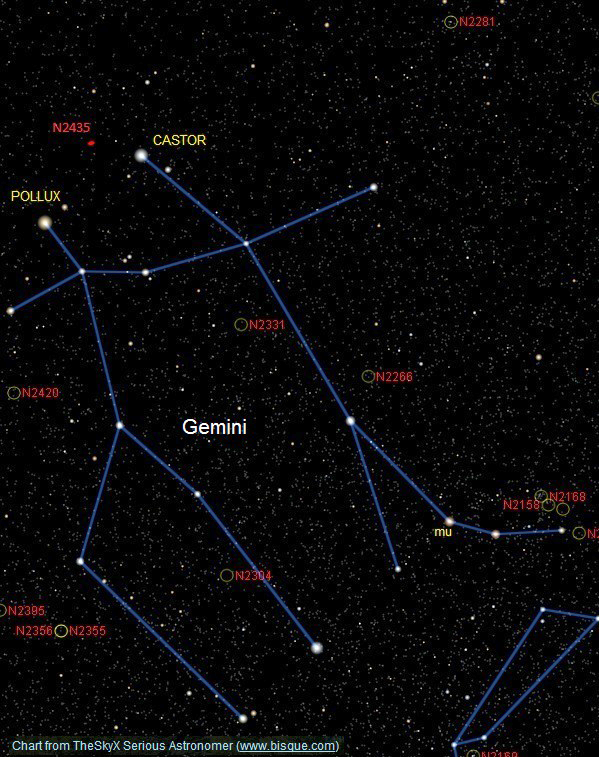Celestial Twins
Last month we looked at the winter sky along with the brighter stars that light the night. Of the dozen stars that reside in a handful of constellations, two belong to the constellation Gemini the Twins. In mythology, Castor and Pollux were born true twins but of the pair, only Pollux was immortal. At 34 light-years away, Pollux measures 10 solar masses and is some 46 times brighter than our day time star. Pollux is a K(0) giant orange star that is the parent star to one extrasolar planet measuring almost three times that of Jupiter and lies as close as Mars to our Sun.
Castor, on the other hand, lies another 17 light-years past Pollux for a total of 51 light-years from us. This white, class A star that actually splits into two in an eyepiece and is named Castor A and Castor B. I remember visiting Jack Newton a few years ago and seeing the pair in the late afternoon with his 16-inch scope. Now that was impressive. The pair is presently closest in their 400-year orbit. To add to the mix, each of these suns is a spectroscopic binary in which the members of Castor A orbit each other in 9.2 days and Castor B in 2.9 days.

Of course, the premiere object residing within Gemini’s boundaries is the 5th magnitude open cluster M35. Keeping in mind the asterism of Gemini is a depiction of twins, M35 is positioned off to the right of Castor’s foot, M35 takes up the size of the full moon and is located 2,400 light-years away. Enjoy this collection of some 120 stars in binoculars or telescope but you will need magnification to nail down a much fainter open cluster catalogued NGC 2158. At magnitude 8.6 this faint but rich cluster is only one-sixth the lunar width or 5 arc minutes. It is also 6.5 times farther than M35. Since these two objects lie less than on degree from the ecliptic, Kodak moments can be captured when planets appear to drift by the clusters. This will be the case when Venus passes by on the morning of July 5th and Mars swings by on the morning of August 5 of this year. When the Moon closes in, its glow usually washes out M35.
NGC 2266 is a dense but very old cluster. Astronomers estimate its age as one billion years old. NGC 2266 is a triangular shape to it and because of its age possesses a good quantity of red stars. Its distance is 10,000 light-years, measures 7 arc minutes and is listed as 10th magnitude.

NGC 2392 or the Eskimo Nebula is a must to locate, observe and photograph. AKA the Clownface Nebula, NGC 2392 is a bipolar – double-shell planetary nebula located 2,800 light-years away. What appears as a parka is the result of strong winds blowing from the star in the centre and creating these lovely long orange filaments which measure about a light-year in length. One thing to remember is photography will pick out colour. When looking through the eyepiece, the planetary will appear green but you should still make out some structure. What a spectacular object.
Most of the galaxies belonging to Gemini are in the 14th to 15th magnitude range and quite a challenge. Furthermore, most of them are simply elliptical without the classic arm structure. There is however NGC 2435 - an elongated in shape with a bright central core but that is about all. It is listed at magnitude 12.7 with an overall measurement of 2.2 X 0.5 arc minutes and an estimated distance of 49 million light-years. NGC 2435 is located just over two degrees east of Castor.

We must now bid Jupiter an official goodbye as it sinks farther and farther west. On March 1st the King of Planets is 871 million km from us compared to 765 million km at the beginning of 2011. With the increased distance we see a slightly smaller disk and have to battle seeing and turbulence with more Earth atmosphere. Jupiter will fade by the third week of the month. Although very low, try to view it on the 15th as Mercury will be two degrees to the upper right of Jupiter – see if you can spot them.
As we lose one grand planet from view, we gain another. Saturn is now up in the east by 9 p.m. and is 1.3 billion km from Earth. There is a noticeable difference in the tilt of the rings from last year and the show will only get better. Saturn is currently in Virgo and will be staying there for a while.
The Moon is a fascinating place at any time of the month when visible. Each night brings on a slightly different angle of the Sun illumination. This results in seeing detail at better times than others. Every now and then certain features come to life in a different way. Such as the crater Werner located at 28 degrees south or three-quarters down the terminator (dividing line between the lit and unlit sides). On any sunlit day, the crater looks like any other. But as the first rays of sunlight strike it at a very sharp angle, magic appears. It is known as the Lunar X and for good reason.
For that brief moment, the very low angle light hits the crater Werner and forms a letter X – hence the name. This will occur on the night of March 11 at 11 p.m. eastern time. The Moon will be 41.9 percent lit. Try to find it along the terminator and sketch or image it. The Zodiacal Lights are still putting on a nice display in western skies after sunset. The planet Jupiter is nestled within its beam. You must have a clear sky and not have any moonlight interference.
The Full Worm Moon (largest in 2011) occurs on March 19th with the much-awaited Spring Equinox set for the 20th at 7:21 EDST. Yes daylight savings time, so do not forget to move those clocks ahead in most provinces one hour at 2 a.m. on Sunday morning at 2 a.m. the 13th. And Be sure to watch the moon on Sunday night at 7 p.m. EDST as it occults magnitude 3.2 mu Geminorium.
Until next month, clear skies everyone.
